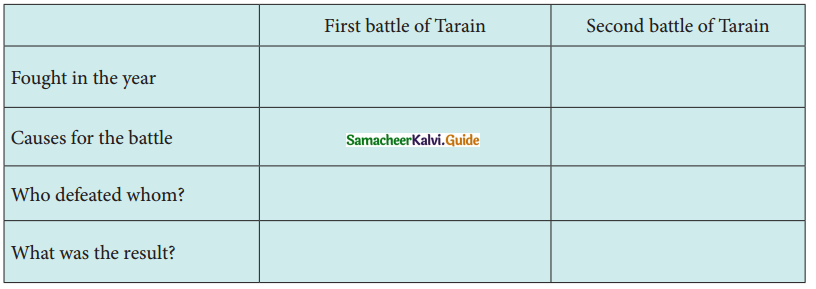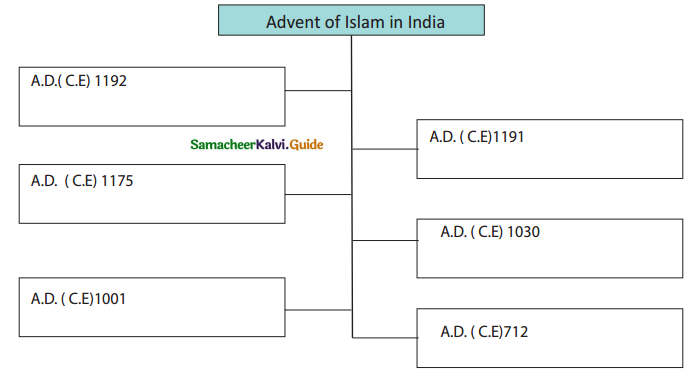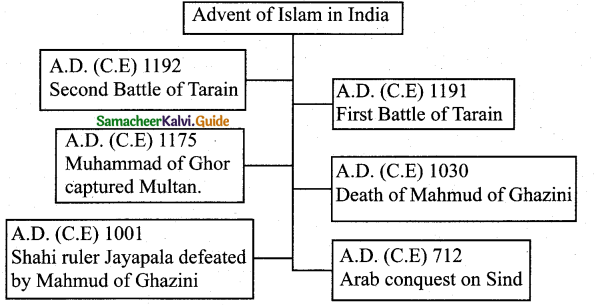Tamilnadu State Board New Syllabus Samacheer Kalvi 7th Social Science Guide Pdf History Term 1 Chapter 2 Emergence of New Kingdoms in North India Text Book Back Questions and Answers, Notes.
Tamilnadu Samacheer Kalvi 7th Social Science Solutions History Term 1 Chapter 2 Emergence of New Kingdoms in North India
7th Social Science Guide Emergence of New Kingdoms in North India Text Book Back Questions and Answers
I. Choose the correct answer:
Question 1.
Who wrote Prithivirajraso?
a) Kalhana
b) Vishakadatta
c) Rajasekara
d) Chand Bardai
Answer:
d) Chand Bardai
![]()
Question 2.
Who was the first prominent ruler of Pratiharas?
a) Bhoja I
b) Naga Bhatta I
c) Jayapala
d) Chandradeva
Answer:
b) Naga Bhatta I
Question 3.
Ghazni was a small principality in ………………
a) Mangolia
b) Turkey
c) Persia
d) Afghanistan
Answer:
d) Afghanistan
Question 4.
What was the most important cause of the invasion of Mahmud of Ghazni?
a) To destroy idolatry
b) To plunder the wealth of India
c) To spread Islam in India
d) To establish a Muslim state in India –
Answer:
d) Chand Bardai
![]()
II. Fill in the blanks:
1. ………… was the founder of Vikramashila University.
Answer:
Dharmpala
2. Arabs conquered Sind in …………….
Answer:
712 A.D ( C.E)
3. The city of Ajmer was founded by ………………….
Answer:
Simharaji
![]()
4. The Khandarya temple is in ……….
Answer:
Madhya Pradesh
III. Match the following:
| A | B |
| 1. Khajuraho | a) Mount Abu |
| 2. Sun temple | b) Bundelkhand |
| 3. Dilwara Temple | c) Konark |
Answer:
| A | B |
| 1. Khajuraho | b) Bundelkhand |
| 2. Sun temple | c) Konark |
| 3. Dilwara Temple | a) Mount Abu |
IV. True or False:
1. Rajputra is a Latin word.
Answer:
False
2. King Gopala was elected by the people.
Answer:
True
![]()
3. The temple at Mount Abu is dedicated to Lord Shiva.
Answer:
False
4.Raksha Bandan is a festival of brotherhood.
Answer:
True
5. Indians learnt the numerals 0-9 from Arabs.
Answer:
False
![]()
V. Consider the following statements. Tick (✓) the appropriate answer:
Question 1.
Assertion : The tripartite struggle was to have control over Kanauj.
Reason : Kanauj was a big city.
a) R is the correct explanation of A.
b) R is not the correct explanation of A.
c) A is wrong and R is correct.
d) A and R are wrong.
Answer:
a) R is the correct explanation of A.
Questions 2.
Statement I : Mahipala could not extend his domain beyond Benaras.
Statement II : Mahipala and Rajendra Chola were contemporaries.
a) I is correct
b) II is correct
c) I and II are correct
d) I and II are false.
Answer:
c) I and II are correct
![]()
Question 3.
Assertion: India’s Islamic period did not begin after Arab conquest of Sind in AD (CE)712.
Reason: Gurjara Pratiharas gave a stiff resistance to Arabs.
a) R is the correct explanation of A
b) R is not the correct explanation of A.
c) A is correct and R is wrong.
d) A is wrong and R is correct.
Answer:
c) I and II are correct.
Question 4.
Assertion: The second battle of Tarain was lost by Prithiviraj.
Reason: There was disunity among the Rajputs,
a) R is the correct explanation of A.
b) R is not the correct explanation of A.
c) A is correct and R is wrong.
d) A is wrong and R is correct.
Answer:
a) R is the correct explanation of A
VI. Answer in one or two sentences:
Question 1.
Write about the tripartite struggle over Kanauj.
Answer:
- There was a tripartite struggle between the Gujara Pratiharas of Malwa, the Rashtrakutas of Deccan, and the Palas of Bengal wanted to establish their supremacy over the fertile region of Kanauj.
- In this process, all their powers were weakened.
![]()
Question 2.
Name any four Rajput clans.
Answer:
The Pratiharas, the Chauhans, the Solankis, and the Paramaras of Pawar’s.
Question 3.
Who was the founder of the Pala dynasty?
Answer:
Gopala was the founder of the Pala Dynasty.
Question 4.
Mention the first two early Caliphates.
Answer
Umayyads and the Abbasids.
![]()
Question 5.
Name the ruler of Sind who was defeated by Qasim.
Answer
Dahir the ruler of Sind who was defeated by Qasim.
VII. Answer the following:
Question 1.
What was the impact of the Arab conquest of Sind? (point out any five)
Answer:
The impact of the Arab conquest of Sind was
- Islam was spread over Indian regions.
- Arab Scholars translated Sanskrit books into Arabic.
- The importance of zero was learned by Arabs from India.
- The Arabs learned the numerals 0 to 9 from India.
- The people in the west and the Arabs learned the game of chess from the Indians.
![]()
VIII. HOTs:
Question a.
Difference between Mahmud Ghazni’s invasion and Muhammad Ghor’s invasion.
Answer:
Mahmud Ghazni invasion:
Mahmud of Ghazni conducted 17 raids into India. He initially raided the shahi kingdom. After his victory over Shahi and Waihind, he extended his rule over Punjab. But his subsequent raids were aimed at plundering the rich temples and cities of North India. Some of the cities were Nagarkot, Thaneshwar, Mathura, and Anhilwad. He plundered the famous temple of Somnath, breaking the idol.
Muhammad Ghor’s invasion:
Muhammad of Ghor who was initially a vassal of Ghazni took over its control after the death of Mahmud Ghazni. Unlike Ghazni, he wanted to extend his empire in India and captured Multan and Punjab.
Question b.
Find out

Answer:

IX. Students Activity:
Question a.
Word Splash (Students discuss what they know about the words given here. They use the words from what they have learnt in a narrative form)
Harsha, Rajputs, Kanauj, Vikramashila, Prithiviraj, Caliph
Answer:
- Harsha: A famous king of the Rajput clans.
- Rajputs: Rajputra Means scion of the royal blood. They are known for their valour and chivalry. They ruled northern and central India.
- Kanauj: A very fertile region, there was a prolonged tripartite struggle between Pratiharas of Malwa, Rashtrakutas of Deccan and the Palas of Bengal.
- Vikramashila: Dharmapala, the pala king founded Vikramashik Monastery, which became a great centre of Buddhist learning.
- Prithiviraj: Prithiviraj Chauhan, the last of Chauhan’s kings, was considered the greatest of all Chauhan rulers.
- Caliph: Caliph means a representative of Prophet Muhammad.
![]()
b. Time Line:
Write the event for the given year in each column.

Answer:

XI. Answer Grid:
Question 1.
Who was the Shahi ruler of Punjab defeated by Mahmud of Ghazni?
Answer:
King Jayapala
Question 2.
Rajput style of Painting is called
Answer:
Rajasthani
![]()
Question 3.
How many Rajput clans were there?
Answer:
36
Question 4.
Who established the first Islamic empire in India?
Answer:
Muhammad of Ghor
Question 5.
Who was the first Sultan of Delhi?
Answer:
Qutb-ud-din Aibak
Question 6.
Where is Mecca?
Answer:
Arabia
![]()
7th Social Science Guide Emergence of New Kingdoms in North India Additional Important Questions and Answers
I. Choose the correct answer:
Question 1.
Which was the rallying point for Rajputs?
a) Chittor
b) Jaipur
c) Purandar
d) Railear
Answer:
a) Chittor
Question 2.
One of the four prominent clans of the Rajputs ruled from Gurjaratra in Jodhpur.
(a) Palas
(b) Pratiharas
(c) Chauhans
(d) Chalukyas
Answer:
(b) Pratiharas
Question 3.
How many Hindu and Jain temples in Osian?
a) 14
b) 15
c) 16
d) 17
Answer:
c) 16
Question 4.
Who was the President of Vikrama Shila Monastery?
a) Dharmapala
b) Devapala
c) Atisha
d) Sakambari
Answer:
c) Atisha
![]()
Question 5.
At which century Abbasid caliphates were declined?
a) 6th
b) 7th
c) 8th
d) 9th
Answer:
d) 9th
Question 6.
Muhammed bin Qassim defeated the ruler of sind
a) Mohammed Nabi
b)Dahir
c) Sabutissin
d) Ummayyad
Answer:
b) Dahir
Question 7.
Which was the capital of sind?
a) Aror
b) Knnauy
c) Tamila
d) Chittor
Answer:
a) Aror
Question 8.
Which game of Indians was learned by Arabas?
a) Hockey
b) Polo
c) Dice
d) Chess
Answer:
d) Chess
![]()
Question 9.
The famous Somnath temple expedition of Ghazni was held in
a) 1000 A.D
b) 1010A.D
c) 1025 A.D
d) 1030A.D
Answer:
c) 1025 A.D
Question 10.
The most capable general of Muhammed Ghor was
a) Qutb – ud – din Aibak
b) Malik Kafur
c) Khan Sahib
d) Iltumish
Answer:
a) Qutb-ud-din Aibak
II. Fill in the blanks:
1. The Rajput States formed a collective entity called ……………………
Answer:
Rajputana
2. Tomaras were ruling in the ………………….. region.
Answer:
Harayana
![]()
3. Thirty-six royal Rajput clans were listed by ………………. in 1829.
Answer:
James Tod
4. Harichandra laid the foundation of the ………….. dynasties
Answer:
Gujarat
5. ………………….. was the first and prominent ruler of Pratiharas.
Answer:
Nagabhatta I
6. Deva Pala donated 5 villages to…………………..
Answer:
Buddhists
7.The Founder of the second Pala dynasty was…………………..
Answer:
Mahipala I
8. The Chauhans capital was…………………..
Ans:
Sakambari
9. A was the bride choosing the bridegroom of her choice.
Answer:
suyamwara
![]()
10. Rajasthani painting focuses on…………………..themes.
Answer:
religious
11. The Khajuraho in Bundelkhand has …………………..temples.
Answer:
30
12. The Palas were adherents to …………………..school of Buddhism.
Answer:
Mahayana
13. The monk ………………….. reformed Tibetan Buddhism.
Answer:
Atisha
14. Islam originated at …………………..in Arabia.
Answer:
Mecca
![]()
15. The founder of Islam was Prophet…………………..
Answer:
Muhammad Nabi
III. Match the following:
| A | B |
| 1. Dharmapala | a) 997 – 1030 |
| 2. Mahipala -I | b) 988 – 1038 |
| 3. Kajini Muhammed | c) 1191- 1192 |
| 4. Muhammed Ghori | d) 770- 810 |
| 5. Battle of Tarani | e) 1149- 1206 |
Answer:
| A | B |
| 1. Dharmapala | d) 770- 810 |
| 2. Mahipala -I | b) 988 – 1038 |
| 3. Kajini Muhammed | a) 997 – 1030 |
| 4. Muhammed Ghori | e) 1149- 1206 |
| 5. Battle of Tarani | c) 1191 – 1192 |
IV. True or False:
1. Muhmud Ghazini conducted 15 Raids into India.
Answer:
False
2. Rajapala was the ruler of Kanauj.
Answer:
True
![]()
3. The Palas were the followers of the Hinayana school of Buddhism.
Answer:
False
4. The Chauhan’s were the foundatories of the Prathikaras.
Answer:
True
5. Monastery is the place where the monks live.
Answer:
True
V. Find the odd one out:
1. Dharmapala, Mahipala, Devapala, Simharaji
Asnwer:
Simharaji
![]()
2. Mandu, Gwalior, Chanderi, Kumbhalgarh
Answer:
Kumbhalgarh
VI. Consider the following statements. Tick (✓) the appropriate answer:
Question 1.
Assertion (A): Mahipala I was called the founder of the second Pala dynasty.
Reason (R): Mahipala I was the powerful ruler of the Pala dynasty,
a) R is the correct explanation of A.
b) R is not the correct explanation of A.
c) A is correct and R is wrong.
d) A is wrong and R is correct.
Answer:
a) R Is the correct explanation of A.
Question 2.
Assertion (A): In the 11th and 12th century many local kings making themselves Independent.
Reason (R): The Rajputs fought each other endlessly.
a) R is the correct explanation of A.
b) R is not the correct explanation of A.
c) A is correct and R is wrong.
d) A is wrong and R is correct.
Answer:
a) R is the correct explanation of A.
![]()
Question 3.
Consider the following statements and find out which is/are correct.
1. The Arabs learned the numerals o tp 9 from Indians
2. The game of chess was learned by Arabs from Indians.
3. Indians learned the importance of 0 from Arabs.
4. Through the ArabsEurope gained more knowledge in mathematics
a) 1,2 and 3 are correct.
b) 1, 2, and 4 are correct.
c) 2, 3, and 4 are correct.
d) 1, 2, and 4 are correct.
Answer:
b) 1, 2, and 4 are correct.
VII. Answer in one or two sentences:
Question 1.
Point out the achievement of Dharmapala.
Answer:
- Dharmapala was a powerful ruler of the Pala dynasty. He led a successful campaign against Kanauj.
- He was a great patron of Buddhism. He founded Vikramashila Monastery.
Question 2.
Who were Chauhans?
Answer:
- Chauhans were the feudatories of Prathiharas and staunchly stood by them to check the Arab invasions.
- Prithiviraj Chauhan was considered the greatest of all Chauhan rulers.
![]()
Question 3.
Mention the importance of Rajput Forts.
Answer:
The strong fortress of Rajputs was situated in Chittorgarh, Ranathambhor and Kumbahlgarh Mandu, Gwalior, Chanderi, and Asirgarh.
Question 4.
Name the important palaces of Rajputs.
Answer:
Palaces of Mani Singh at Gwalior, lake palaces at Udaipur, Jodhpur Palace, and Jaipur Palace.
Question 5.
Write a note on Dilwara Temple at Mount Abu.
Answer:
The Dilwara Jain Temple at Mount Abu has a white marble hall and a central dome of 11 concentric rings and a richly curved valuated ceiling and pillars. It was built during the period of Rajput rulers.
VII. Answer the following:
Question 1.
Name some important Rajput buildings.
Answer:
Some of the important examples of the Rajput buildings are the strong fortresses of Chittorgarh. Ranthambhore and Kumbhalgarh (all in Rajasthan), Mandu, Gwalior, Chanderi, and Asirgarh (all in Madhya Pradesh).
![]()
Question 2.
Describe the expeditions of Mahmud of Ghazni.
Answer:
- Mahmud of Ghazni conducted 17 raids into India.
- The initial raids were against the Shahi kingdom and its King Jayapala was defeated in 1001 A.D.
- The Successor of Jayapala, Anand Pala fought against Mahmud in the battle of Waihind and defeated in 1008 A.D.
- In 1011 he raided Nagarkot in Punjab hills and Thaneswar.
- In 1018 Mahmud Plundered the holy city of Mathura and attacked Kanauj.
- He raids Gujarat and in 1024 A.D. (CE) Mahmud defeated Solanki King and plundered Anhilwad.
- He sacked the famous temple of Somnath by breaking the idol.
- His last campaign was through Sind in 1030A.D. (CE).
- Mahmud died in 1030 A.D.